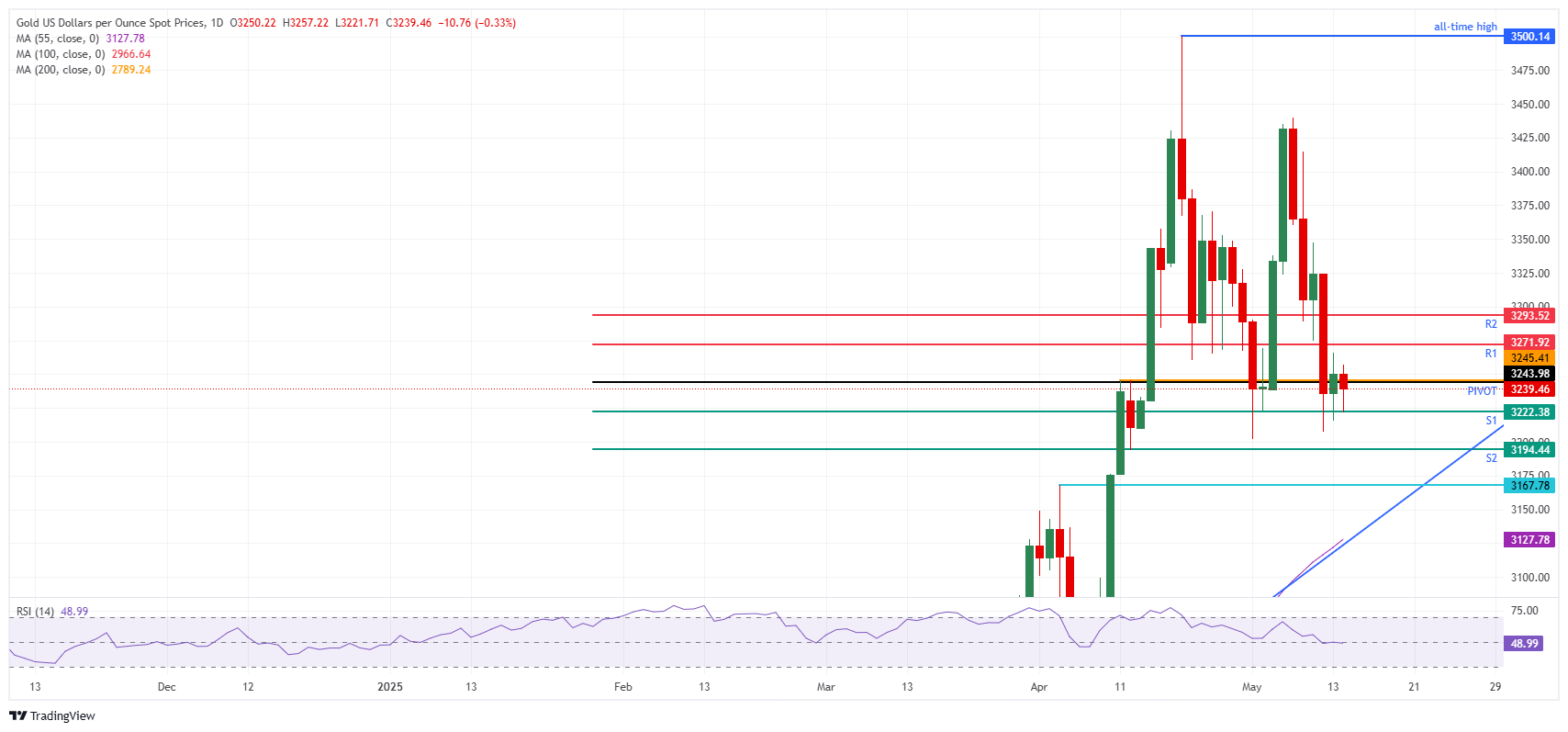- Gold price sees Monday’s gains dampen and sees more losses for this week.
- Traders assess the recent US inflation reading on the outlook for interest-rate cuts from the Fed.
- More downside for Gold could come if President Trump announces more trade deals.
Gold (XAU/USD) dips back to $3,231 on Wednesday while selling pressure returns, erasing almost all the gains registered on Tuesday. The softer-than-expected inflation reading for April released on Tuesday, gave markets a push to head into Risk On assets, with the widely-feared inflation shock from tariffs not materializing yet. The softer-than-expected reading for both the monthly Headline and core components boosted a relief rally in equities and led investors to price in more Federal Reserve (Fed) rate cuts for this year.
Without any top-tier data releases for Wednesday in the Economic Calendar, markets will look for further clues after President Donald Trump visited Saudi Arabia and secured $600 billion in trade deals. On Thursday, Ukrainian President Volodymyr Zelenskyy is said to be ready to meet Russian President Vladimir Putin in Istanbul for peace talks, although Putin hasn’t confirmed his attendance. Both Europe and the US have urged Putin to come to Istanbul, while new sanctions are being weighed as countermeasures if peace talks do not take place.
Daily digest market movers: Gold still in focus according to UBS
- Gold is facing more downside pressure, several analysts and Gold traders confirm to Bloomberg. “The US-China tariff rates surprised materially to the downside, which eases investor concerns around trade-driven growth risks,“ said Justin Lin, an analyst at Global X ETFs. “Capital is likely flowing out of defensive sectors and Gold,” he added.
- Still, the Gold rally could possibly not yet be out of steam, according to Amy Lo, UBS head of wealth management in Asia. UBS Group AG’s rich clients are increasingly shifting away from US-dollar assets, turning instead to Gold, crypto and investments in China. “Gold is getting very popular,” Amy Lo said in an interview with Yvonne Man at Bloomberg’s New Voices event Tuesday in Hong Kong.
- India’s trade deficit likely narrowed to $18.9 billion in April from $21.5 billion in March. The contraction in the deficit was partly due to a drop in Gold imports – a surge in prices likely reduced demand for the metal. A sharp drop in crude Oil prices is also expected to lower Oil imports, countering a typical seasonal jump in volumes.
Gold Price Technical Analysis: Breakout trade
Despite the selling pressure on Wednesday, a fresh low for this week has not materialized as Monday’s low at $3,207 hasn’t been tested.. Gold appears to be in a consolidation stage, with lower highs and higher lows. Whichever gets broken first will see further follow-through towards either $3,300 or $3,200.
The daily Pivot Point at $3,243 needs to be reclaimed first in case of any recovery. In case of a breakout, out of the consolidation, the R1 at $3,271 will certainly be tested. Not for from there, the R2 at $3,293 is possibly the last level to offer firm resistance before entering the $3,300 area again.
On the downside, the daily S1 support at $3,222 already offered ample support in Asian trading. In case a breakout materializes, look for the S2 at $3,194 before the pivotal technical support at $3,167 will pop up.

XAU/USD: Daily Chart
US-China Trade War FAQs
Generally speaking, a trade war is an economic conflict between two or more countries due to extreme protectionism on one end. It implies the creation of trade barriers, such as tariffs, which result in counter-barriers, escalating import costs, and hence the cost of living.
An economic conflict between the United States (US) and China began early in 2018, when President Donald Trump set trade barriers on China, claiming unfair commercial practices and intellectual property theft from the Asian giant. China took retaliatory action, imposing tariffs on multiple US goods, such as automobiles and soybeans. Tensions escalated until the two countries signed the US-China Phase One trade deal in January 2020. The agreement required structural reforms and other changes to China’s economic and trade regime and pretended to restore stability and trust between the two nations. However, the Coronavirus pandemic took the focus out of the conflict. Yet, it is worth mentioning that President Joe Biden, who took office after Trump, kept tariffs in place and even added some additional levies.
The return of Donald Trump to the White House as the 47th US President has sparked a fresh wave of tensions between the two countries. During the 2024 election campaign, Trump pledged to impose 60% tariffs on China once he returned to office, which he did on January 20, 2025. With Trump back, the US-China trade war is meant to resume where it was left, with tit-for-tat policies affecting the global economic landscape amid disruptions in global supply chains, resulting in a reduction in spending, particularly investment, and directly feeding into the Consumer Price Index inflation.

